Virtual Suburbia
Monday, July 17, 2023
While it is kind of amazing that this site is still up and running, for as much as people talk about stuff on the internet lasting forever sometimes it doesn't.
Back in the day I uploaded most of the Second Life screenshots for this blog to image hosting sites SL Universe and Snapzilla (aka slpics dot com) run by one of the OG residents. Tonight I was reminiscing a bit and starting to think about re-launching another old project, when my travels brought me back here via Hamlet Au's New World Notes, which is still going strong (F-yeah Hamlet!).
I noticed that most of the images (linked from SL Universe / Snapzilla) on these posts weren't displaying properly, and when I attempted to follow the links back to the source I was redirected to a different site entirely, at which point my security software stepped in and said "whoa big fella, I see we've got ourselves some malware on that site so maybe we won't go there."
So yeah that happened, and I don't know for how long it has been happening. I think the only responsible thing to do would be edit the posts and redact the images, but it's going to take a while. So the next most responsible thing, maybe, aside from taking the whole blog down, is to put up a post on the homepage.
So here we are.
It's kind of nice to be back, even if the circumstances suck. Sad to lose the images, sorry for the inconvenience. Stay safe out there.
-C
Friday, May 08, 2009
Just my Two Fingers
...on the radial artery of this blog, that is.Its Follow Friday for @chippoutine, and I was thinking of people who click on the link in my profile only to find another dead blogspot site.
Well, its not dead dead, something more akin to being nestled in a cocoon, hunkered down for a long and slow metamorphosis.
In the meantime, I've been posting some random sketches and other cruft over at the blog of our somewhat less nascent virtual design atelier - www.priondesign.com
As well, if you're interested, have a look at www.simvineyard.com, which documents the development of a Second Life island completed for a startup California winery. The island has since been taken offline, however you might find the blog to be an interesting read. Some of the "SL blog roundups" seem to indicate that simvineyard is actually more active than this site. *sighs*
Finally, feel free to peruse the archives around here, and if you like what you see let me know - perhaps the cocoon might start to resemble a piñata.
Thanks for stopping by!
-C.
Wednesday, June 13, 2007
Gathering Refuge

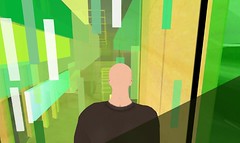
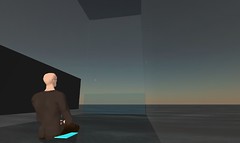
In addition to the Royal Institute of Technology Stockholm's LOL Architects utilizing Second Life as a tool for architectural education (previously mentioned here and here), this post at Sharon B's Mindtracks reports at least one more university utilizing the metaverse to teach design and problem-solving skills, namely the School of Architecture and Design at Australia's RMIT University.
Very much like LOL's sim, RMIT Island (view on map | direct teleport | website) is an explosion of ideas that attempts to push the boundaries of architectural possibility, arguably blurring the lines between space, sculpture, graphics, and information in a manner not for the timid and seldom achieved in corporate builds.
While both islands present amazing works ranging from the slightly polemic to the downright esoteric, if the two were to be compared it would seem that the LOL students have had more freedom to define their own project parameters, with the RMIT projects appearing more focused by virtue of a relatively explicit design brief. For example here is the programme for the first of two assignments (the other being a space of gathering) completed over the course of the studio:
Project 1: Lost - A Space of RefugeAs a result most of the RMIT projects felt to some degree like buildings as opposed to installations, yet it also seemed like the RMIT students were designing objects to be explored through camming rather than avatar movement. While one is compelled to dispense a healthy amount of leeway given the experimental nature of these works, many were frustrating to navigate and others entirely uninhabitable. In such cases personal impressions quickly degrade from breathless to just huffy.
Design a space of refuge that is inhabitable by two to three people and examines the architectural relationship between interior, exterior and landscape. Inform this design by reading Borges’ short story on the relationship between the map and its territory, and develop a spatial and cultural understanding of refuge through architectural design.
Among the notable exceptions is Dinah Cortes's take on the Refuge project. In case you were wondering, it's the green thing pictured above. Quoting from the notecard dispensed at the entry:
The sequence of different spaces, lead the visitor to walk through a gradual initiation of darkness, light colours and sounds in being more aware of one’s true nature and relationship to the rest of the existence. Reaching a stage of isolation and contemplation, the viewer can experience a kind of meditative reverence, bringing out the vibrant spirit of nature.Perhaps excluding the grandiose part about having me relate to the rest of existence, this eye-catching build does what it says. Simple, elegant, expressive, and even a little profound. I'd give it seven thumbs up.
Or maybe just an A.
Tuesday, June 05, 2007
Korova Milk Bar
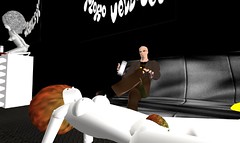
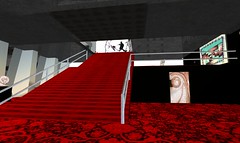
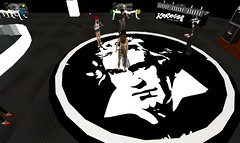
Speaking strictly from personal observation, the residents of Second Life have spent considerable energy creating spaces inspired by literary reference. Some are based on specific authors and works such as John Norman's Chronicles of Gor, others are simply evocative nods to science fiction and fantasy novels that lack obvious attribution. Star Wars fandom notwithstanding, there seem to be far fewer spaces drawing their inspiration from traditional cinema (an admittedly clumsy qualifier used to differentiate it from the rise of spaces serving machinima, whether they take the form of backlot sets or personalized screening rooms).
While first envisioned in the words of Anthony Burgess, A Clockwork Orange is better known from the film that made him infamous, and the Korova Milk Bar in the sim of Geoje (view on map | direct teleport | website) is not the first build in SL to hatch as the spawn of impresario Stanley Kubrick. In the archives of New World Notes Hamlet Au reported on Korov-oid tribute spaces dating as far back as 2005. Nor can the genius of the man be contained in-world, as one is reminded every time the grid goes down - heck, I've even used that flick as a reference in one of my earliest posts on this site, not to mention a subsequent review of a prefab known as 'Slightly Droog.'
That hasn't deterred Italian SL residents Mavi Beck and Franci Kubrick from being the latest to settle into the meme and make it their own in a way that (intentionally or not) belies the detached coolness and soulless hedonism depicted in the movie. A shared sense of cinematic immersion seems to instead evoke a kind of kinship with one's fellow avatars that cuts through the usual personal barriers of bling and bootylicious-ness.
Franci and Mavi have out of necessity elaborated upon the stark and partial glimpses of the bar as presented in the film. The walls feature the same scrawled menu of drug-laced dairy products seeping from brightly lit porcelain nudes (although they didn't serve drencrom, which is what I was drinking). Filling in the gaps however are a number of more whimsical elements, like a giant spinning turntable dance floor emblazoned with the giant spinning head of Ludwig Van. The bar itself is accessed by ascending a staircase from an art gallery on the ground floor. While the artworks currently on display are themselves compelling and the framegrab tableau of ultra-violence one encounters at the top of the stairs quite powerful, the entreatment to "Be a Smart Droog - Rent a Shop in Korova Milk Land" takes the whole thing down a peg.
So while these additional elements are executed to varying degrees of conceptual consistency, it could be argued that the flaws of this build are in fact what yield its charms. If one accepts the notion that presence in a literary world is all about disappearing, perhaps presence in a cinematic world is all about being seen. This iteration of the Korova Milk Bar has a definite lived-in feel, infused with the personality of its builders.
All of which leaves your humble narrator unable to look away, and hungry for ticks of toast.
Wednesday, April 04, 2007
The Ties That Bind
[Images Redacted]
The post reminded me of my own time spent on the color sims, which for many represent the 'old world' of the grid. While working on the Mauve Infohub I'd occasionally check out the surrounding environs where a simple sculpture on Green called 'The Ties That Bind' (view on map | direct teleport) managed to attach itself to the nether regions of my brain.
We've previously explored the theme of ephemerality in Second Life architecture, how the ability to instantly erase or conjure a build from inventory makes it seem in some senses disposable. Yet at the same time this very volatility leads one to savour the structures as they manifest themselves in the moment, insecure in the knowledge that at any other given moment they could be gone, perhaps forever. Edifice in the physical world, one might suggest, could in fact be easier to take for granted and/or even dismiss, easily shuffled into 'mental inventory' with the comfort of knowing it is going to take significant effort (and copious explosives) for a building to be removed.
Where the comparison falls down, of course, is when we begin to compare the material qualities of the 'stuff' that captures and envelopes real versus virtual space. A real brick wall does a lot of things that a virtual one can't, like withstand being crushed under the weight of the bricks above it, feel cold and rough to the touch, taste like dirt, smell like...you know what I mean. There's a certain completeness to the way in which these materials are 'read' that tends to outweigh the effects of ephemerality described above. Add some recreational drugs into the mix and one might call it a draw.
So what happens when the stuff of virtual architecture stops trying so hard to achieve the sense of gravitas it hopes to gain by incompletely imitating that which we have come to know in the physical world? Arguably it has the potential to make up for these deficiencies, take on its own character, and sit alongside physical architecture on a continuum of spatial experience.
In a small way, this is precisely what 'The Ties That Bind' appears to do, with Lordfly's post nudging me to document it before it disappears.
While not necessarily inhabitable in the same way as other works of Second Life architecture (unless one's avatar happens to be very very small (and a distinct possibility BTW)), the slipperiness of scale afforded by the camera allows viewpoints from within as well as around the sculpture, a diminutive collection of tortured prim ribbons that when considered as a whole come together to form a very complex, evocative, and gestural surface, a victory for raw expression over rational geometry the likes of which not commonly seen in-world.
It achieves its surface qualities through an apparent lack of concern for providing any sort of enclosure or 'envelope', and a seeming disinterest with being a building at all. And yet for me anyway it alights in the imagination as the facade of a distant skyscraper that upon approach transforms into something different altogether. While far less likely to be seen hanging from a rear view mirror, the closest analogue is perhaps the Native American notion of the dream catcher as a filter for unseen forces of imagination, allowing us to pause and perhaps perceive things may have been, or things that may never be.
